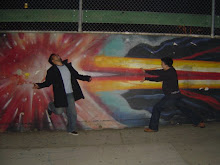.jpg)
The previous two Learn to Box posts covered Target Areas and Stance. Now that you know wear to aim for, and how to stand in order to keep yourself protected, it's time to learn the most important punch in boxing: The Jab.
How to throw the jab
The jab is a straight punch thrown with the lead (front) hand, which would be the left hand for an orthodox boxer. If any of that sounds foreign, you may want to refer back to the post about the orthodox stance. The jab is a long rang punch, and is thrown in a straight path, drawing the shortest distance between your lead hand and your opponent's face. There are dozens of different kinds of jabs, but in general, the jab is one of the fastest, safest punches to throw. Let's see how it's done.

Here the two opponents face each other, each in orthodox stance with their left leg forward, and left hand forward.
+tutorial.jpg)
Here we see the fighter on the right side starting to throw a jab.
(A) He is pushing off slightly with his back foot, pushing himself towards his opponent.
(B) The fist is beginning to rotate, with his palm beginning to turn down towards the ground.
(c) The elbow should remain pointed down towards the ground as long as possible. If the elbow juts out to the side, the jab will not be as fast or as straight.
+tutorial.jpg)
Here we see the jab connecting with the opponent's face.
(A) For a long, powerful jab, the front heel should pivot at the last second, with the toes planted, and the heel rotating towards the target. This heel rotation adds a couple inches to your punch and adds power from your hips into your jab.
(B) The left shoulder should be rotated up towards the face. This protects the left side of your chin from a counter punch.
(C) The left palm should be fully rotated down towards the ground by the point of impact. This rotation adds snap to your jab and also naturally rotates your shoulder up as indicated in (B).
(D) A good jab will cause your opponent's head to snap back, setting them up for further attack or scoring points with the judges.
Here is different angle for the jab.

Note how the jab can cut between the gloves of the opponent, landing clean on the face. If the opponent has their left hand lower, it makes it even easier to connect with the jab.
Here is a breakdown for the jab from a front angle.

(1) Assume the initial stance. It is important to always start from this position so as to not telegraph your punches. If you change your stance as you prepare to throw a punch, your opponent will be able to read your movements and easily avoid your punch.
(2)
a. The left hand begins to rotate towards the ground.
b. The elbow remains pointed towards the ground.
c. The shoulder gradually rotates upwards towards your left chin.
(3) The jab connects
a. The fist is fully rotated, palm facing the floor.
b. The arm should be straight, elbow pointing sideways.
c. The shoulder should be rotated up towards the chin, protecting it from attack. The chin should be pressed down towards your chest.
d. The right glove should still be held high, just below the eye, protecting your right side from attack.
(4-5) Your left hand should return back to the initial position in the same route it traveled, the shortest path possible. This will protect your from any counter punches, or it will allow you to throw other punches.
This post has focused on the proper method to throw the jab. The next post will go into some common mistakes as well as a uses of the jab. For now, practice, practice, practice, and then practice some more. The jab can be tiring to throw and hard to get used to, but a solid jab is the basis behind any good boxer. Till next time!

Dude, your breakdowns are amazing. I love the artwork as well.
ReplyDelete